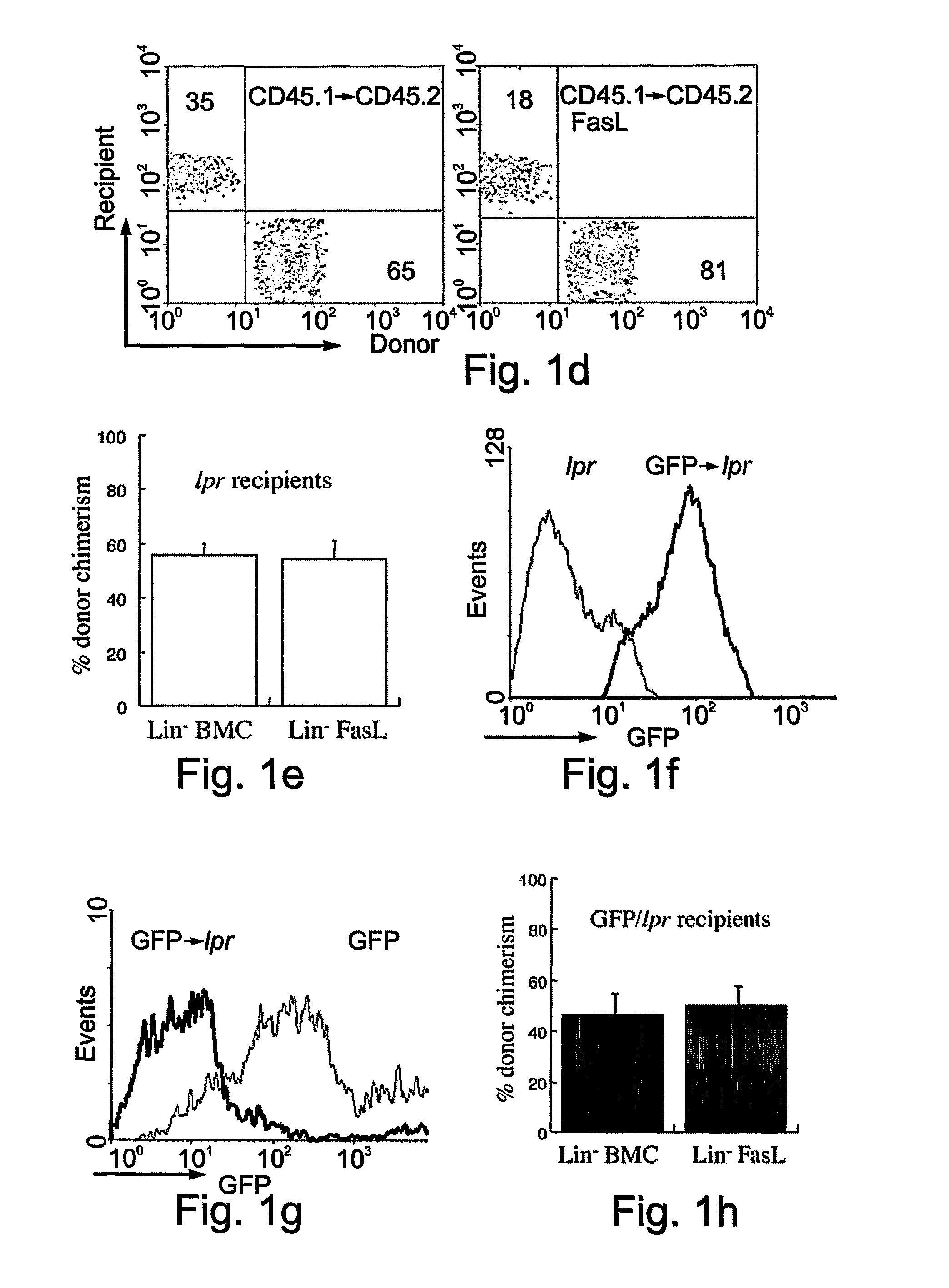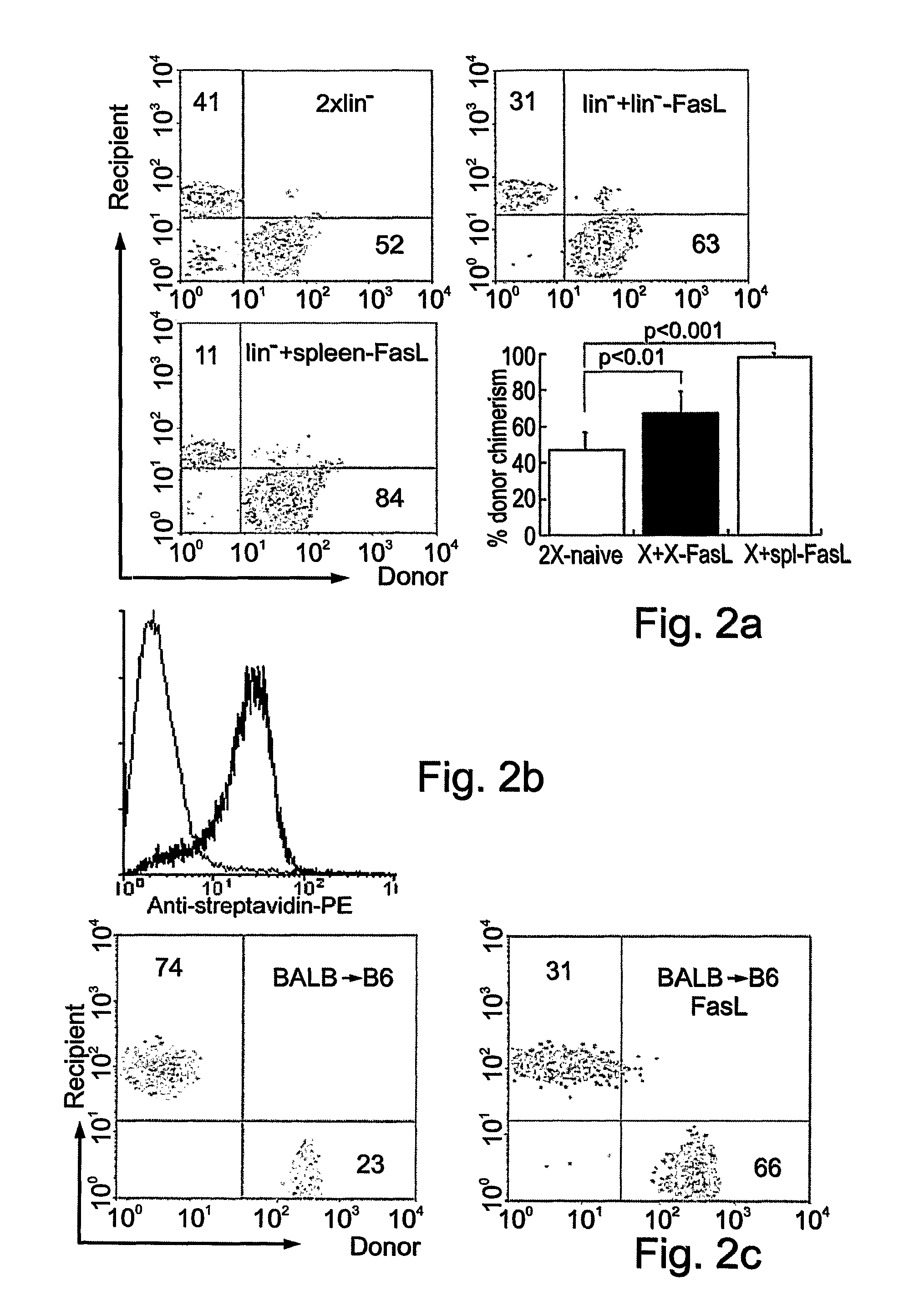Methods of selecting stem cells and uses thereof
a stem cell and cell technology, applied in the field of stem cell selection, can solve the problems of hematopoietic cells rarely survive, damage to the cells resulting from the removal of these materials, and severe damage to the stroma
- Summary
- Abstract
- Description
- Claims
- Application Information
AI Technical Summary
Benefits of technology
Problems solved by technology
Method used
Image
Examples
example 1
Physiological Fas Activation in Hematopoietic Cell Engraftment
[0173]Results
[0174]The detrimental consequences attributed to the Fas / FasL interaction in hematopoietic cells would suggest a negative impact in the context of hematopoietic stem and progenitor cell (HSPC) transplants. Suppressive activity of this interaction would suggest that Fas-defective HSPC have an engraftment advantage due to insensitivity to Fas-mediated regulation and / or suppression of donor cell activity. To test this possibility, the present inventors used Fas-defective (lpr) and FasL-defective (gld) mice in syngeneic transplants, to circumvent the immunogenic mechanisms involved in graft rejection and graft versus host disease (GVHD), and to isolate the role of this molecular pair in the early engraftment process. Transplantation of 106 lin− BMC from either wild type (CD45.1) or Fas-defective (lpr, CD45.2) donors into myeloablated (950 rad) syngeneic GFP recipients (CD45.2) resulted in full donor chimerism in ...
example 2
Transient Display of Ectopic FasL Protein Improves Syngeneic Cell Engraftment
[0176]Results
[0177]To determine whether the engraftment deficit of gld cells would be restored by FasL, the donor cells were coated with a FasL protein via biotinylation. Expression of FasL protein on the surface of donor gld cells restored their engraftment deficit (p<0.001) in syngeneic wt recipients (FIG. 1C). A similar effect was observed when FasL-expressing wt cells were transplanted into gld recipients (p<0.001), suggesting donor FasL-host Fas interaction and apparent autocrine Fas / FasL activity in the engrafting cells. Modulation of engraftment was attributed to specific effects of FasL, and not to secular effects of protein decoration on the surface of cells. Decoration of wt-BMC with FasL protein via biotinylation improved (p<0.005) early engraftment in syngeneic wt recipients (FIG. 1D), and the mice proceeded to develop full donor chimerism at 16 weeks post-transplantation. These results suggest ...
example 3
The Primary Target of the Donor Cell FasL is the Marrow Stroma in Syngeneic Transplants
[0178]Results
[0179]To ascertain whether the engraftment-facilitating effect of ectopic FasL protein operated through Fas signaling in the host, cells from wild type mice were transplanted into Fas-defective lpr recipients (n=8). The engraftment advantage achieved by expression of the FasL protein on the surface of the cellular allografts was lost, indicating that the mechanism involved a competent Fas signaling pathway in the host (FIG. 1E). These results were further proof that the enhanced engraftment of FasL decorated cells was a specific effect of FasL and not an artifact of ex vivo cell manipulation.
[0180]A veto activity of FasL-decorated lin− BMC may operate at the systemic level, where it prevents destruction of pre-homed BMC by the host immune system, or in the bone marrow, where it may remove the residual host cells that survived irradiation. In syngeneic transplants, immune modulation wo...
PUM
| Property | Measurement | Unit |
|---|---|---|
| flow rate | aaaaa | aaaaa |
| concentrations | aaaaa | aaaaa |
| concentrations | aaaaa | aaaaa |
Abstract
Description
Claims
Application Information
 Login to View More
Login to View More - R&D
- Intellectual Property
- Life Sciences
- Materials
- Tech Scout
- Unparalleled Data Quality
- Higher Quality Content
- 60% Fewer Hallucinations
Browse by: Latest US Patents, China's latest patents, Technical Efficacy Thesaurus, Application Domain, Technology Topic, Popular Technical Reports.
© 2025 PatSnap. All rights reserved.Legal|Privacy policy|Modern Slavery Act Transparency Statement|Sitemap|About US| Contact US: help@patsnap.com



